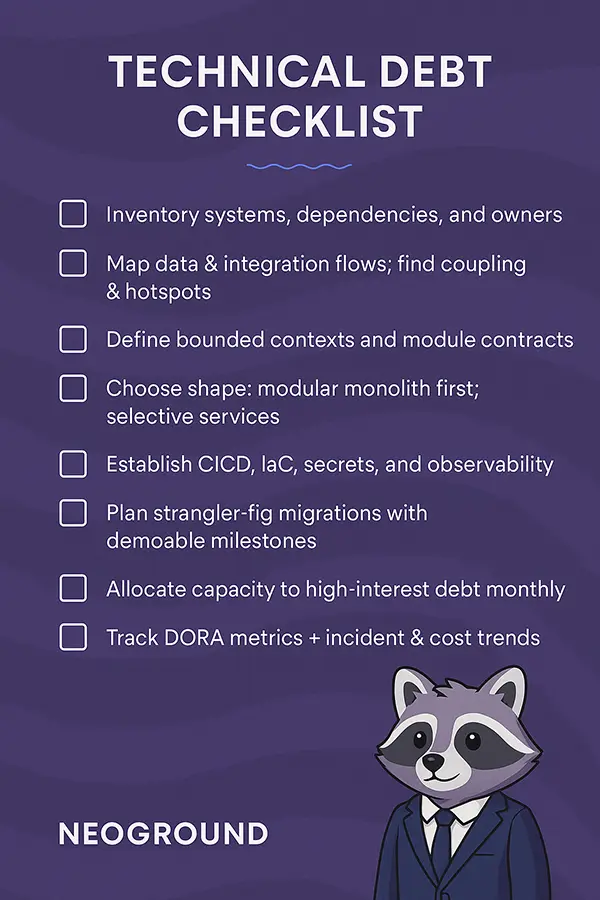TL;DR
- Tech debt isn’t just messy code; it’s a structural drag on innovation, speed, hiring, and security.
- Modernization ≠ 1:1 replacement. It’s rethinking assumptions, modularizing around clear boundaries, and simplifying.
- Start small, move fast: audit → prioritize → modularize → automate → measure.
- Outcomes: faster releases, fewer incidents, happier teams, lower TCO – and room to innovate again.
The weight you don’t see
I’ve walked into companies where everything “works” – until you try to change anything. Releases feel heavier than last quarter. “Small” changes take two weeks. There’s that one module nobody wants to touch. You can feel the friction before you can name it.
That friction has a name: technical debt. And it’s the silent killer of innovation because it doesn’t fail loudly – it just slows you down until you stop moving.
What tech debt really is (and how it creeps in)
Tech debt isn’t “bad developers” or “old code.” It’s the accumulation of decisions made under pressure:
- “Temporary” patches that became permanent.
- Monoliths that fit yesterday’s needs but resist today’s change.
- Toolchains maintained by one person who’s about to leave.
- Hardware that once made sense, now propping up workarounds.
Individually these choices are rational. Collectively, they compound like interest. You’re paying the premium in slower delivery, brittle systems, and lost opportunities.
Tell-tale signs you’re paying the innovation tax:
- Deployments get longer each month
- Every fix breaks something else
- “We can’t upgrade because X depends on Y from 2017”
- No one wants to touch specific modules
- Feature discussions start with “What could this break?”
The cost (beyond “it’s slow”)
When debt owns you, innovation becomes negotiation with the past:
- Speed & opportunity: time-to-value stretches; windows close.
- Talent: strong engineers avoid brittle stacks; your best people spend their energy firefighting.
- Security & compliance: upgrades lag; unknown dependencies linger.
- Focus: leadership debates workarounds instead of outcomes.
If your team spends more time avoiding problems than creating solutions, you’re already paying interest.
Modernization is not swapping old for new
When I advise clients, I rarely recommend “rewrite the monolith in the latest framework.” That’s just yesterday’s logic in tomorrow’s syntax. Modernization is about rethinking the shape of the system.
What has consistently worked in the field
- From monolith to modular clarity A classic pattern: we carve out domains with clean boundaries (auth, billing, content, search). Sometimes that becomes a modular monolith (one deploy, well-separated modules). Sometimes microservices where it pays off (clear SLAs, scaling needs, independent lifecycles). The goal is cohesion + autonomy, not “microservices for the badge.”
- Consolidate hardware into a modern Linux platform We’ve replaced rooms of aging boxes with one performant Linux server (or a small cluster) running containers/VMs. Pair that with modern storage, proper backups, and IaC, and you reclaim reliability, performance, and power efficiency – while ditching fragile snowflake setups.
- Replace many weak tools with one strong platform Instead of patching five dated systems, a unified platform (or a well-selected SaaS) can reduce glue code, shrink maintenance, and simplify onboarding. Fewer moving parts, clearer responsibility.
- Rethink the approach entirely Sometimes the right move is to change the workflow, not just the tech: event-driven integrations instead of nightly cron scripts, edge caching instead of scaling the origin, a headless CMS rather than hand-rolled content modules.
Modernization principle: Free yourself from yesterday’s assumptions, not just yesterday’s libraries.
A practical playbook (the way I run it)
1) Audit for clarity
- Inventory: systems, modules, dependencies, versions, owners.
- Map flows: how data moves; where coupling and toil live.
- Find hotspots: slow releases, high-incident areas, single-points-of-failure.
- Surface constraints: licenses, compliance, budget, hiring realities.
Output: an Architecture Clarity Map (current state) and a prioritized list of bottlenecks.
2) Design the target state (fit for purpose)
- Bounded contexts: define domains and their contracts.
- Choose the shape: modular monolith first; microservices where autonomy/scaling is truly needed.
- Data strategy: schemas, ownership, change strategy, and observability.
- Platform baseline: containers, CI/CD, IaC, secrets, SSO, logging/metrics/tracing.
Output: Target Architecture with explicit trade-offs.
3) Plan the path (risk-first)
- Strangler-Fig approach: replace high-value edges first; keep the core stable until you’re ready.
- Milestones you can demo: 2–6 week increments with visible wins.
- Backwards compatibility: adaptors and anti-corruption layers to avoid “flag days.”
- Safety nets: progressive delivery, feature flags, blue/green, solid rollback.
Output: a Migration Roadmap that ships value continuously.
4) Build the rails so teams can run
- Pipelines: fast tests, reproducible builds, artifact storage.
- Environments: dev/stage/prod with parity; ephemeral envs for PRs.
- Guardrails: code style, templates, golden paths, internal docs.
- Observability: SLOs per module; dashboards that show user-level health, not just CPU.
5) Reinforce the culture
- Ownership: every module has an owner (rotations are fine; “nobody” is not).
- Documentation as a habit: architecture notes that actually help the next person.
- Decision logs: record why you chose X over Y; future-you will thank you.
- Regular “debt sprints”: a fixed percentage of capacity pays down high-interest items.
What changes when you do this right
- Decision velocity returns. Roadmaps discuss outcomes, not workarounds.
- Lead time shrinks. Small changes ship fast; big ones feel possible.
- Incidents drop and recoveries are quicker. Clear boundaries = contained blast radius.
- Costs stabilize. Less “mystery toil,” better capacity planning, smarter hardware use.
- Teams are happier. People like working on systems that make sense.
Measure it: deployment frequency, change lead time, MTTR, defect rate, dependency freshness, infra cost per request, and developer satisfaction. If these improve, innovation follows.
Field notes (three patterns I keep seeing)
The “fear zone” module. One area nobody dares to touch. We isolate its interface, write contract tests, carve it out behind an adaptor, and replace it in two increments. Result: fear gone, features unblocked.
Cron-spaghetti to event-driven. Nightly scripts chained across servers. We replace with a simple queue and a couple of consumers. Suddenly retries, visibility, and throughput are boring–in the best way.
Hardware zoo to one strong box. A stack of aging machines replaced by a single modern Linux server with containers and proper backups. Same workload, lower power, higher reliability, cleaner ops.
Common objections (and how we handle them)
“We can’t pause features.”
You don’t have to. We ship modernization in thin vertical slices that deliver user value on the way.
“Microservices will slow us down.”
They can – if done everywhere. We start with a modular monolith and only split when autonomy or scaling truly demands it.
“Rewrites fail.”
Big-bang rewrites do. The Strangler-Fig approach avoids the cliff by replacing high-leverage edges first.
“This will be expensive.”
Debt is already expensive. Modernization reallocates that spend into assets that compound: faster delivery, fewer outages, happier teams.
A cultural shift (the part most people skip)
Tech debt is rarely just technical. It’s cultural: “ship now, think later.” Modernization sticks when leadership frames it as strategic renewal, not housekeeping. Reward clarity. Celebrate paying down high-interest debt. Make documentation and decision logs part of how you build, not an afterthought.
Design systems that help your best people do their best work.
A handy checklist

Your next move: audit before it hurts
If your systems feel heavier than they should, it’s time to look directly at the friction. The earlier you uncover high-interest debt, the easier it is to act.
Neoground Architecture Audit
We’ll map your architecture, surface bottlenecks, and give you a sequenced modernization roadmap that balances speed, safety, and ROI – whether that means carving a monolith into modules, consolidating onto a modern Linux stack, or replacing five weak tools with one strong platform.
Let’s restore your decision velocity. Audit your current architecture with Neoground – Contact Us Today.
This article was created by us with the support of Artificial Intelligence (GPT-5).
The title image is AI-generated by us using Sora.




No comments yet
Add a comment